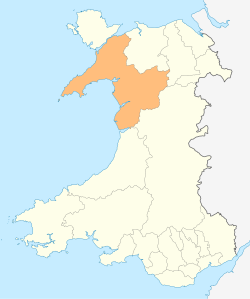Corris
| Corris | |
|---|---|
 Church at Corris | |
Location within Gwynedd | |
| OS grid reference | SH755078 |
| Community |
|
| Principal area | |
| Preserved county | |
| Country | Wales |
| Sovereign state | United Kingdom |
| Post town | MACHYNLLETH |
| Postcode district | SY20 |
| Dialling code | 0165473 |
| Police | North Wales |
| Fire | North Wales |
| Ambulance | Welsh |
| UK Parliament | |
| Senedd Cymru – Welsh Parliament | |

Corris is a village in the county of Gwynedd, Wales, about 4.5 miles (7 km) north of the town of Machynlleth. The village lies on the west bank of the Afon Dulas (which here forms the boundary with Powys), around that river's confluence with the Afon Deri. Corris railway station is the headquarters and museum of the Corris Railway, a preserved narrow gauge railway.
The area has a community council. The community council system replaced the former parish council system and tackles local issues, as well as acting as a contact point between local government and residents for information and resources on various issues. The community elects one member to represent the Corris/Mawddwy ward on Gwynedd Council.[1] Besides Corris, the ward covers Mawddwy community to the north-east.[2]
Buildings and architecture
[edit]Former Vicarage
[edit]The former vicarage for Holy Trinity Church, Corris, was commissioned in the 1870s and designed by the architect Henry Kennedy (1814–1896), who undertook extensive ecclesiastical and parochial work across north-west Wales during the nineteenth century.[3] A tender notice for the construction of the Corris vicarage was published in 1874.[4]
The vicarage occupies a hillside position above the A487 between Corris and Machynlleth. Historically, it was approached from the village by a footpath along the slope overlooking the Dulas valley. The building reflects Kennedy’s characteristic approach to rural clerical residences, combining practical siting with the broader programme of parish development in Gwynedd during the late Victorian period.
The Church in Wales sold the property in 1973 for £11,000, after which it was converted into a public house.[5] In the late twentieth and early twenty-first century it returned to use as an accommodation venue, making the building accessible to the public once again.
Notable people
[edit]- Edward Hurst Davies (1855–1927) Quarry manager and owner
- Rhisiart Morgan Davies (1903–1958) Welsh physicist
- Herbert Harold Disley quarry manager and father of John Disley.
- John Disley (1928–2016), Olympic medal winning athlete[6]
- Kathy Jones (born 1968), Anglican priest and Dean of Bangor[7]
Further reading
[edit]Slate Quarrying at Corris, by Alun John Richards, 1994, ISBN 0863812791
References
[edit]- ^ "Your Councillors". Gwynedd Council. Retrieved 4 April 2022.
- ^ "Election Maps: Great Britain". Ordnance Survey. Retrieved 4 April 2022.
- ^ "Henry Kennedy (architect)". Wikipedia.
- ^ "Corris Vicarage: Tender for Builders (1874)". Welsh Newspapers Online. National Library of Wales. Retrieved 22 November 2025.
- ^ "Auction of Former Vicarage, Corris (1972)". The British Newspaper Archive. Retrieved 22 November 2025.
- ^ Peter Nichols (17 February 2017). "John Disley obituary". The Guardian.
- ^ "'Welcome home!' for the Diocese of Bangor's new Dean". Diocese of Bangor. Church in Wales. 21 January 2016. Archived from the original on 3 February 2016. Retrieved 28 January 2016.
External links
[edit]| Preceding station | Following station | |||
|---|---|---|---|---|
| Maespoeth Junction | Corris Railway | Terminus | ||
| Historical railways | ||||
| Maespoeth Junction | Corris Railway | Garneddwen | ||



